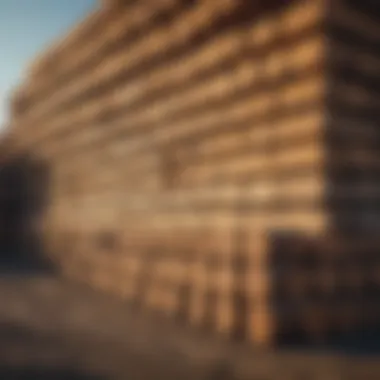Understanding Costs of 4x4 Treated Posts


Intro
Understanding the cost of 4x4 treated posts isn't merely an exercise in number crunching. It encompasses a broader look into the factors that affect pricing in construction and landscaping domains. As demand rises for durable, treatment-enhanced wood, the specific dynamics of the market come into play. It's important to break down these costs to appreciate how they influence decision-making in diverse projects ranging from fences to garden structures. Beyond just materials, the factors like geographic nuances, market trends, and supplier variations significantly steer the price tag you may encounter.
In this article, we will navigate through these vital aspects, giving forestry professionals, construction contractors, and savvy DIYers clear insights into the comprehensive landscape of treated wood pricing.
Understanding Woodland Ecosystems
Importance of Biodiversity in Forests
Forests serve as vital ecosystems, teeming with life forms from towering trees to the tiniest microorganisms. Biodiversity within these woodlands plays a key role in maintaining healthy forest ecosystems. The range of species is crucial—not just for the immediate ecological benefits but also for the economic aspects tied to forestry products, including treated wood.
- A diverse makeup of species can lead to stronger resistance against diseases, pests, and climate variations.
- Higher biodiversity promotes richer nutrient cycles, affecting tree growth and the quality of timber produced.
Without vibrant biodiversity, the products we rely on, like treated posts, could become scarce, driving up costs and impacting broader environmental health.
Role of Forests in Climate Regulation
Forests are often seen as the lungs of the planet, but their role stretches far beyond that. Indeed, they act as carbon sinks, absorbing carbon dioxide and moderating climate patterns. Additionally, healthy forests contribute to local and global climate stability by influencing rainfall patterns and maintaining watershed health.
- They assist in regulating temperature, impacting local agricultural practices, and subsequently, material costs in related sectors.
- As forest health declines, the repercussions on treated wood costs can arise, leading to a fluctuating market.
Sustainable Forestry Practices
Principles of Sustainable Forestry
To preserve these precious ecosystems, sustainable forestry practices have been gaining traction. The principle here is to manage forests responsibly, ensuring a balance between ecological stability and economic gain. This involves:
- Regenerative practices that allow woodlands to recover post-harvest.
- Selective logging that minimizes environmental impact, ensuring diverse growth remains unobstructed.
By embracing sustainable practices, the forestry sector safeguards the future supply of treated wood while potentially stabilizing market pricing.
Case Studies of Successful Implementations
Examining regions that have effectively adopted sustainable techniques can yield insights into best practices.
- Example 1: The state of Oregon has implemented forest management plans that prioritize both timber production and ecosystem health, leading to healthier trees and sustained post quality.
- Example 2: In Sweden, forestry operators emphasize biodiversity, thus ensuring higher-quality timber that requires less intensive treatment, positively impacting the final cost.
Woodland Stewardship Techniques
Forest Management Plans
Implementing comprehensive forest management plans helps ensure steady, high-quality timber production without harming the ecosystem. These plans often encompass:
- Inventory assessments to monitor tree health and growth rates.
- Managed harvest schedules that align with natural growth cycles.
Such strategic planning enables more informed decision-making, ultimately influencing the type of treated wood that makes it to the market and at what cost.
Conservation Strategies
Lastly, effective conservation strategies within forestry not only protect biodiversity but also prevent price surges tied to scarcity of quality materials. Techniques can include:
- Establishing protected zones to maintain natural habitats.
- Engaging communities in conservation efforts, rewarding them for sustainable practices.
Implementing these strategies might require initial investment, but the long-term benefits—including cost stabilization for products like treated posts—can be significant.
Investing in sustainable practices not only protects our forests but also assures a more stable economy for forestry products.
Understanding Treated Wood
Treated wood plays a critical role in numerous applications, ranging from small-scale gardening to large construction projects. Understanding the nature and benefits of treated wood not only helps in making informed purchasing decisions but also impacts the longevity and performance of the structures we build. The treatment processes enhance the wood properties, making it more resilient against environmental stresses. This section will explore fundamental aspects of treated wood, including the definition of treatment, common techniques used, and the advantages that such wood can provide.
What Does Treatment Mean?
Wood treatment refers to the process used to enhance the durability and resistance of wood against various deteriorating factors. This can include chemical treatments, pressure treatments, and even thermal ones that alter the wood's natural properties. By treating wood, we are essentially prolonging its life span and usability, making it a practical choice for construction and landscaping projects.
Common Treatments for Wood
When discussing treated wood, it's essential to highlight the various treatments available. Here are a few notable options:
Pressure treatment
Pressure treatment is among the most used methods, where wood is placed in a large chamber and subjected to high pressure. This forces preservatives deep into the wood fibers, significantly enhancing its protection against decay and insect infestations. One key characteristic of pressure-treated wood is its affordability—considered a cost-effective solution for many. However, a downside can be the chemical emissions associated with the treatment process, which some users find unappealing.
Borate treatment
Borate treatment involves the application of borate compounds, which are natural mineral salts. This method is especially effective against fungal decay and insect damage. An appealing aspect of borate-treated wood is its lessened environmental impact compared to other treatment methods. The unique feature of borate treatment is that it does not require high-pressure applications, making it more accessible for DIY projects. However, this wood may not be suitable for wet environments, as borate can leach out if exposed to excessive moisture.
Heat treatment
Heat treatment is a process where wood is heated to high temperatures to achieve sterilization and increase durability without using chemicals. This is a more environmentally friendly option since it avoids toxic substances. A key benefit of heat-treated wood is that it often expands its resistance to pests and fungi. One potential downside is the wood can become more susceptible to warp or shrinkage if not managed properly, which could impact its structural integrity over time.
Benefits of Using Treated Wood


Using treated wood offers several significant advantages that make it a highly sought-after material:
Moisture resistance
Moisture resistance is perhaps the most talked-about benefit. Treated wood can effectively repel water, reducing the chances of rotting, warping, or cracking. This characteristic is particularly crucial in regions with high humidity or heavy rain. It's also worth noting that while treated wood helps manage moisture, it's not entirely waterproof, and proper care should still be given to maintenance.
Decay resistance
Decay resistance is another vital element of treated wood. This quality ensures that wood can withstand the ravages of time, keeping structures intact longer than untreated options. Treated wood is less prone to fungal attacks, which is invaluable for outdoor projects. However, not all treated wood is created equal, and understanding the specific decay resistance of each treatment type helps in choosing the right material for the job.
Insect protection
Treated wood provides a strong line of defense against insects, particularly termites, which can wreak havoc on wooden structures. By utilizing wood that has been treated to resist these pests, property owners can save on repair and replacement costs in the long term. The added insect protection extends not only to outdoor projects but can be vital even in indoor settings, where pests may be present.
The durability and versatility of treated wood make it a compelling choice for forestry professionals and builders alike, providing significant advantages in various landscapes.
Overall, understanding treated wood—the processes involved and its inherent benefits—sets the stage for evaluating the cost of specific products, including those 4x4 treated posts. As this article progresses through each aspect of the pricing factors, having a grasp on these foundational elements is crucial for effective decision-making.
The Dimensions of 4x4 Treated Posts
When embarking on a construction or landscaping project, the dimensions of the materials can be a key player in determining feasibility and overall success. With 4x4 treated posts, understanding their dimensions goes beyond just numbers. It’s about how those measurements fit within the broader context of your project. Key factors include stability, load-bearing capacity, and aesthetic appeal. For instance, a miscalculation in dimensions could lead to structural integrity issues or aesthetic inconsistencies. Hence, proper grasp of these measurements is critical before diving into installation or purchasing.
Standard Measurements
The term "4x4 treated post" typically signifies a wood post that measures 4 inches by 4 inches. However, in the lumber world, the reality can be a bit more nuanced. Most lumber dimensions refer to nominal sizes rather than actual sizes. This means that the posts, once milled and treated, often measure somewhat smaller than their stated dimensions. For instance, a standard 4x4 often measures around 3.5 inches by 3.5 inches.
Realizing these differences is crucial for anyone involved in projects using these posts, as it affects how they interlock with other components, particularly in fence installation or structural framing. A discrepancy here could lead to inadequate connections or even failure in joining materials properly. Top-notch attention to detail with these measurements results in a sturdier and more reliable structure.
Variations in Size and Shape
Variations in size and shape for treated posts cater to diverse project needs. While standard dimensions serve most applications, unique scenarios call for customized solutions.
Actual vs. nominal size
The distinction between actual and nominal size can be a game changer. When wood is cut, it’s typically milled to a nominal size, which is often larger than the actual dimensions once it has dried. Understanding this discrepancy helps in architectural design and engineering. Choosing nominal sizes is popular among builders because they offer predictability in planning. However, it’s essential to not overlook that the actual size can slightly vary, especially in treated wood.
The actual size impacts everything from installation to the overall look of your project. A builder might plan for 4 inches, but if they don't account for the actual measurement of about 3.5 inches, it could lead to a misalignment in joins or fittings.
Custom sizes
Custom sizes provide flexibility, allowing professionals to adapt to specific project requirements. If the standard dimensions of 4x4 posts don't quite cut it for the unique aesthetic or design demands, custom sizes become a viable solution. Their key characteristic lies in adaptability; they help craft individualized solutions that can better fit unique landscape features or architectural planning.
For example, if a project requires posts that support a non-standard fence height, customizing the length can ensure both aesthetic and functional balance. However, while this approach offers great benefits in customization, it can sometimes lead to higher costs and longer lead times to procure the specific dimensions.
In summary, evaluating both the standard and custom dimensions of 4x4 treated posts is not just about choice; it’s about making informed decisions that enhance the effectiveness and integrity of your construction or landscaping project.
Evaluating the Cost Factors
When embarking on a project that involves 4x4 treated posts, assessing the cost factors is as essential as finding the right timber itself. This section dives into various elements that drive up or down the cost of these posts, giving you the clarity you need to make informed decisions. Understanding these cost components not only helps in budgeting but also plays a significant role in evaluating the quality and longevity of the materials chosen for your project.
Material Source and Quality
The source of your treated posts and their overall quality can greatly affect their price. Generally, wood that is sustainably sourced with certification tends to carry a higher price tag. On the flip side, cheaper, lower-quality wood might lead to greater expenses down the line, like replacement costs or added maintenance.
Recognizing the importance of where your wood comes from is crucial. If you’re aiming for durability and resistance to decay, investing in higher-quality materials sourced from reputable suppliers could save you a lot of hassle later on. It’s that old saying, you get what you pay for!
Geographic Location Impact
When it comes to purchasing 4x4 treated posts, your geographic location can play a significant role in determining costs. Let’s break this down into two key considerations: regional availability and transport costs.
Regional availability
The availability of certain types of treated wood can change depending on where you are. In regions where timber is abundant, you might find more competitive pricing due to lower transportation costs and increased local supply. Conversely, in urban areas or places where timber is scarce, prices can spike, as demand may exceed the local supply.
What’s more, if you live in an area with strict regulations regarding wood treatment, that might impact the variety of options presented to you. For instance, areas that prioritize environmental sustainability may focus on sourcing types of treated wood that meet specific standards, which can also skew costs.
Transport costs
Transport costs often add an unexpected layer to the final price of treated posts. Even if the posts are competitively priced at the source, logistics can quickly bump up that number. The distance between the supplier and your location can have a big effect. For example, if you get your posts from a supplier who’s miles away, you could be looking at hefty shipping fees.
Moreover, shipping costs can also be influenced by fuel prices, which fluctuate seasonally. So, if you can, sourcing from a local supplier might be a wise move in terms of cost-effectiveness. Now, that said, there’s also the question of the reliability of the supplier and the quality of the service provided.
Market Trends Affecting Prices
Market trends play a pivotal role in shaping the prices of 4x4 treated posts. These trends are not isolated; rather, they are intertwined with broader economic shifts, consumer behavior, and supply chain dynamics. Knowing how these variables dance affects not just the upfront costs of purchase but also the long-term budget for various construction and landscaping projects.
Supply Chain Dynamics
The intricacies of the supply chain significantly impact the pricing of treated posts. Various elements, such as availability of raw materials and production capabilities, can lead to fluctuations. When demand for treated wood increases—say during peak construction seasons—the entire chain gears up to meet these needs. However, disruptions like transportation strikes or natural disasters can choke the supply lines, causing prices to soar.
Moreover, the global market is a chessboard where national policies, tariffs, and trade agreements create ripples. These ripples can manifest as either positive or negative changes in pricing. For instance, if a country imposes tariffs on imported timber, domestic suppliers might benefit short-term, while consumers face hikes in costs due to decreased competition.
Demand Fluctuations
Residential vs. Commercial Use


In the world of treated wood, the distinction between residential and commercial use is critical. Residential projects often have a nimble nature; they respond swiftly to trends in DIY projects or home improvements. This can create localized spikes in demand, making suppliers adjust prices quickly. On the other hand, commercial projects tend to involve bulk orders and longer planning cycles. This characteristic leads to a steadier demand, but price negotiations could see more aggressive tactics from builders wanting the best deal.
This fluctuation means that the market for treated posts can be softer for residential goods yet have a harder edge when dealing with commercial quantities. Each seasonal project—like summer deck builds or autumn fence installations—can make certain times of the year more lucrative.
Seasonal Variations
When it comes to seasonal variations, the cycle can heavily influence purchasing trends. Spring and summer generally see a spike in demand due to favorable weather conditions, making these prime times for buyers looking to undertake construction projects. Consequently, one can expect higher prices during this period since suppliers capitalize on the increase in demand.
On the flip side, winter often brings a slowdown in purchasing activity. Suppliers, wary of overproduction, may drop their prices to clear inventory as they prepare for the next busy season. This cycle provides a unique opportunity for wise buyers to strategize their purchases, picking up materials during off-peak times when prices can dip significantly.
"Understanding the ebb and flow of market demand can unveil opportunities for savings and smarter buying decisions in the realm of treated posts."
In a nutshell, both demand fluctuations and supply chain dynamics intertwine to impact the pricing structure of 4x4 treated posts. For buyers, staying attuned to these trends doesn’t just translate to better financial decisions; it equips them to navigate the complexities of the treated wood market more effectively.
Comparative Costs Across Categories
When gauging the cost of 4x4 treated posts, a vital aspect to consider is their comparative costs across categories. Understanding how treated wood stacks up against untreated wood and various treatment options gives buyers crucial insights into their decisions. This section aims to highlight the implications of these comparisons, noting key elements, associated benefits, and considerations that can affect overall expenditure and project outcomes.
Treated vs. Untreated Wood
The choice between treated and untreated wood fundamentally alters the financial landscape. Treated wood is often more expensive due to the added processing it undergoes to resist moisture, decay, and pests. For instance, while a standard 4x4 untreated post could set you back approximately $5, the treated equivalent might run around $10 or more. This price disparity often triggers questions regarding value versus cost.
In the long run, opting for treated wood proves to be a wise investment; its resilience leads to fewer replacements and repairs. Hence, the upfront investment pays off, thanks to the enhanced durability and longevity of treated wood products. While untreated wood may initially seem like a wallet-friendly option, it's crucial to factor in maintenance expenses and the potential hassle of replacing deteriorated materials more frequently.
Cost Analysis of Different Treatments
The marketplace is rich with various wood treatment options, and each presents its distinct financial implications.
Cost-effectiveness considerations
Cost-effectiveness forms the backbone of many purchasing decisions. Treated wood options such as pressure-treated, borate-treated, or heat-treated posts each cater to specific needs and come with varying costs. Notably, pressure-treated wood tends to be the most affordable among these three. The unique characteristic here lies in its broad availability and multiple applications, making it a popular choice for those on a budget.
On the flip side, more specialized treatments like borate treatments offer enhanced protection against pests and are more environmentally focused. While borate-treated posts may carry a higher price tag, they can also be seen as cost-effective due to their long-lasting performance in the right settings. Buyers must weigh the initial outlay against long-term benefits, recognizing that investment in higher-quality treatments can lead to substantial savings down the line.
Long-term savings
Long-term savings tell an important story in this context. Often, what seems like a greater financial commitment at first glance can morph into considerable savings over time. Treated wood, especially when safeguarded against the elements and invasive species, can last significantly longer than untreated alternatives.
For homeowners and professionals, the unique feature of long-term savings reflects not merely in cost, but also in convenience. Fewer repairs and replacements mean less time and money spent off-site and more resources directed towards other projects. Thus, investing in high-quality treated wood can translate to fewer headaches and improved cash flow over the years, a fact that resonates with both budget-conscious buyers and those looking for robust reliability in their materials.
Purchasing 4x4 Treated Posts
Buying 4x4 treated posts is a crucial step for anyone looking to undertake a construction or landscaping project. The importance of getting this right cannot be overstated; a wise purchasing decision can save time, hassle, and unnecessary costs down the line. This section offers insight into fundamentally key elements, such as where to buy, and how to assess the supplier's reputation to ensure you are making a sound investment.
Where to Buy
When it comes to sourcing 4x4 treated posts, several pathways can be taken. Local hardware stores, lumber yards, and specialized suppliers tend to stock treated wood products. Here's a breakdown:
- Local Hardware Stores: Distributing common treated posts, often characterized by variable pricing depending on promotions and stock.
- Lumber Yards: More variety and sometimes bulk discounts available. They often provide custom cutting to suit your specific project needs.
- Specialty Suppliers: Experts in treated wood, usually offering a range of options that may include various treatment processes or species of wood.
It's vital to consider the characteristics of each option before making a decision. For instance, local hardware stores might offer convenience but may not have the most competitive prices. To maximize value, always compare pricing and availability across platforms. Online marketplaces have also become viable options, allowing you to browse and compare different sellers easily from the comfort of your home.
Evaluating Supplier Reputation
A supplier's reputation is perhaps more than just a number on a review site. It embodies the quality of service, trustworthiness, and the overall experience of previous customers. Here's how to decode what makes a solid reputation.
Customer Reviews
Looking at customer reviews is a powerful way to evaluate potential suppliers. They provide real-life feedback from those who've walked the same path before you, giving insight into the quality of products and customer service. One significant aspect of customer reviews is evidence of consistent satisfaction or issues encountered repeatedly by buyers. High ratings usually indicate reliability, while complaints about poor-quality products should raise a red flag.
Moreover, reviews often underscore key attributes such as:
- Quality assurance: Buyers often highlight specific aspects that define the nature of the material received.
- Service efficiency: Timeliness of delivery, accurate orders, and responsiveness can be frequently commented on.
“In the world of treated wood, knowing what others experienced provides clarity. It’s like having a guide on an uncharted path.”
However, be cautious. Sometimes, reviews can be manipulated or selectively posted. Look for patterns in comments rather than isolated incidents. On platforms like Reddit or Facebook, you'll often find discussions that add layers of understanding to your inquiry.
Longevity in the Market
Supplier longevity in the market is another vital characteristic to consider. A business that has been around for a while often indicates stability and a strong grasp of the industry. This sort of history usually correlates with better relationships with manufacturers, which could translate to higher quality products. Companies that have been in operation for years are likely to have established a loyal customer base and understood the nuances of customer service and product quality over time.
In evaluating longevity, consider the following:
- Market presence: A long-standing supplier often holds a wealth of knowledge not just about products, but the ebb and flow of market trends.
- Adaptability: How well they’ve adapted to changes in wood treatment technologies and regulations can signal their commitment to quality.
On the downside, some long-lasting businesses may rest on their laurels. Sometimes, they may not invest in innovation as newer suppliers do. However, a well-established supplier would still have the reliability factor that’s hard to replicate.
In summary, both customer reviews and the supplier’s longevity in the market are integral components in making an informed choice when purchasing your 4x4 treated posts. This scrutiny not only leads to a satisfactory purchase but also enhances the likelihood of your project thriving based on quality materials.
Using 4x4 Treated Posts Effectively
Using 4x4 treated posts effectively revolves around understanding both practical applications and the nuances that come with these structural components. Treating wood helps prevent decay and insect intrusion, making treated posts particularly advantageous for outdoor projects. However, their usage doesn’t come without considerations, such as proper installation methods and environmental elements that might affect longevity.
In landscaping, these posts can create aesthetically pleasing elements with significant structural functionality. Their application can vary widely—from supporting a fence to anchoring garden features or even creating raised beds. In construction, on the other hand, their strength and versatility offer dependable solutions for both residential and commercial projects. Each application deserves careful thought to ensure success and durability in the environments they inhabit.


Application in Landscaping
Using 4x4 treated posts in landscaping brings both beauty and functionality to outdoor spaces. They can serve as vertical elements, supporting plant life and providing structure. Homeowners may use them as decorative features or practical support for planting beds and trellises. What makes these posts a standout option is their durability against weather conditions, which is vital for landscaping elements exposed to moisture, sunlight, and varying temperatures.
Their unique characteristic lies in the combination of strength and resistance to rot. Adding treated posts can elevate the look of a garden while ensuring it withstands nature's whims. Because of their solid construction, they help maintain the integrity of various structures in landscaping, allowing for peace of mind.
Construction Uses
The construction sector relies heavily on the reliability and strength of 4x4 treated posts. Their importance can be seen across various projects; they are particularly well-suited for building frameworks, which demand durability and stability. The adaptability of these posts also allows builders to incorporate them into diverse architectural designs, from fences to complex frameworks such as post and beam structures.
Fences
When it comes to fences, using 4x4 treated posts ensures that the structure remains upright and secure against both natural elements and the test of time. The key characteristic of these posts is their resistance to rot and harsh weather. This makes them a popular choice for property lines, livestock management, or simply to enhance privacy. Because they’re thicker, they provide a sturdiness that thinner materials can’t match. However, a consideration when opting for treated wood is the need for proper sealing at cut ends to maximize life expectancy, as untreated sections may be prone to moisture absorption.
Decks
Decks are another prominent application. Here, 4x4 treated posts provide foundational support that is key to creating a stable and safe outdoor living area. Their strength and weather resistance mean they can handle the stresses of additional weight from furniture or foot traffic. Treated wood decks are enjoyed for their longevity and lower maintenance compared to untreated ones. An essential point to note is that treated wood may require regular staining or sealing to maintain its appearance, proving that proactive care is still necessary despite the enduring qualities.
Post and Beam Structures
Post and beam structures often utilize 4x4 treated posts to create support systems for heavy loads, especially in larger buildings or outdoor constructions like gazebos. The unique feature of these structures is the visible post and beam framework that adds to the aesthetics of the build. While these posts are beneficial for structural integrity, the potential drawbacks include increased cost due to the quality of treated wood and potential chemical concerns related to the treatment process. Always considering environmental implications helps in making well-rounded decisions, especially when designing around local ecosystems.
While effective use of 4x4 treated posts has clear advantages, the balance between benefits and considerations needs careful thought. Aligning the posts with design intent can significantly enhance the effectiveness of both landscaping and construction projects.
Environmental Considerations
When discussing the cost of 4x4 treated posts, it’s vital to lean into the environmental considerations that shape both consumer choices and industry practices. Sustainability isn’t merely a buzzword—it's an imperative for modern industries. Knowing how treated wood impacts our surroundings informs responsible purchasing decisions and fosters a healthier ecosystem in the long run. Beyond mere economics, evaluating treated wood in this light speaks to a larger conversation about our collective responsibility toward environmental stewardship.
Sustainability of Treated Wood
Sustainability in treated wood revolves around the balance of utilizing natural resources for construction while minimizing ecological footprints. The wood treatment processes, often involving chemicals to enhance durability, must be managed smartly. Many manufacturers are now opting for eco-friendlier chemicals, understanding that green credentials can boost sales. Moreover, sustainable forestry practices aim to ensure that the source materials for these treated posts originate from responsibly managed forests.
- Key characteristic: The durability of treated wood makes it a reliable choice over untreated options, as it requires less frequent replacement, leading to less waste.
- Proper features: Some companies even promote their commitment to sustainability by offering certifications, allowing buyers to choose products that align with their values. This is a step towards ensuring that their purchases do not support unethical logging practices.
Ultimately, choosing sustainable treated wood can delight both builders and buyers, as they contribute to longer-lasting structures without compromising environmental integrity.
Impact on Local Ecosystems
Every decision, even seemingly small ones, ripples out into local ecosystems. Treated wood’s effect on these environments should not be underplayed. The integration of treated wood into landscapes can significantly affect the surrounding flora and fauna, often in positive ways but sometimes otherwise.
Chemical leaching
Chemical leaching is a pressing concern with treated wood. The process happens when water interacts with chemicals in the wood, potentially allowing them to seep into the ground. This is a relevant issue primarily in areas where the treated posts are used near water sources or in high rainfall regions. While modern treatments have been improved to reduce harmful leaching, not all products mitigate this risk equally.
- Key characteristic: A significant pro is the enhanced lifespan of these posts. However, the potential leaching of harmful substances can be detrimental, especially in ecosystems where sensitive species thrive.
- Feature:
- If untreated, wood could break down quickly, further needing replacements, thus increasing its overall environmental impact.
- The choice of treatments, therefore, plays a critical role in weighing short-term gains against long-term ecological effects.
Despite challenges, the right choice can ensure minimal impact.
Best practices in installation
To ensure that treated wood does not adversely impact the environment, following best practices during installation is crucial. Strategies vary, but certain commonalities exist that can help guide responsible sourcing and usage. Properly installing treated posts—not just slapping them into the ground—includes considerations like adequate spacing and selecting the right location.
- Key characteristic: Proper location selection can help prevent water pooling around posts. It also means placing them away from sensitive areas, thus minimizing any potential leaching issues.
- Unique feature: Consider using natural barriers or landscape design elements that can reduce runoff, ensuring that sediment doesn’t wash chemicals directly into nearby water bodies.
Implementing these best practices ensures that the installation of treated wood contributes positively to its surroundings rather than detracting from them.
“The choices we make today about materials can echo through time, influencing both the environment and future generations.”
In sum, being aware of the environmental implications of treated wood, from sustainability to the installation techniques, aids not only individual projects but can significantly shape broader practices across industries.
Future Outlook for Treated Wood Pricing
The topic of the future of treated wood pricing is essential in understanding the cycles of demand and supply that impact financial planning in construction and landscaping projects. As beyond just cost, the trends and predictions play a role in how buyers strategize their purchases. Several elements punctuate this future outlook, including anticipated shifts in raw material availability, evolving environmental regulations, and fluctuating consumer preferences.
Forecasting prices cannot be a one-size-fits-all exercise. As markets have their own nuances, it’s crucial for buyers to stay informed. An awareness of factors such as technological advancements in treatment processes, changes in legislation regarding treated wood, and even climate change can shape cost trajectories. The implications of these trends go beyond mere numbers; they guide professionals in making decisions that will affect project budget and material longevity.
"To navigate the complexities of wood pricing, foresight becomes an essential tool for both seasoned pros and newcomers alike."
Predictions and Trends
A few predictions for treated wood prices suggest they may continue to rise slowly in the foreseeable future. One reason could be the increased costs of raw materials due to disruptions in supply chains. A recent report from wood industry producers indicated that access to sustainably sourced timber is becoming more restricted, which may apply upward pressure on treated wood prices as demand maintains or grows.
In parallel, environmentally friendly treatments are gaining popularity. This trend suggests that while initial costs for these methods might be higher, long-term benefits could balance the books due to their durability and reduced maintenance requirements. Coupled with increasing awareness around climate issues, we might see a more robust market for treated wood that meets eco-friendly standards.
Long-term Strategies for Buyers
Bulk purchasing
Bulk purchasing, for one, can be a game-changer when it comes to managing costs. By buying in larger quantities, professionals can often negotiate significantly better rates per unit. This practice is not just about saving a few bucks; the ability to stockpile materials can lead to smoother project timelines. Having a reliable supply of treated posts makes a significant difference, especially during peak season shortages, when prices tend to spike.
However, buyers should always be mindful of storage conditions. Treated wood needs to be kept dry and properly ventilated to minimize any risk of degradation. On the flip side, if done right, bulk purchasing can be a winning strategy that adds both cost efficiency and peace of mind to a project.
Alternative material considerations
Shifting gears to alternative material considerations is another angle worth exploring. As the world progresses, so too do the innovations in the types of materials available for construction. Buyers may look into composites or other synthetic materials that can offer comparable durability without the downsides associated with natural wood. These alternatives often come with longer lifespans and minimal upkeep needs.
Yet, this route isn’t without its challenges. Many alternative materials might still be in the experimental phase, making them a riskier investment for traditional projects. Balancing the benefits against the unknowns is essential for making a sound decision.
By delving into these strategies, industry professionals can safeguard their interests against the unpredictable landscape of treated wood pricing, ensuring that their projects remain feasible and financially sustainable.







